St. Basil's Cathedral brief information. Description of St. Basil's Cathedral
Freeing Red Square from buildings that “interfere” with large-scale holiday events(parades and demonstrations), Lazar Kaganovich proposed to completely dismantle St. Basil's Cathedral. And in order to convince Stalin that he was right, for clarity, he made a model of the square from which the church could be removed. But everything did not go as he planned: when he took the cathedral from the model, the leader did not appreciate these actions and said a phrase that would go down in the history of the temple forever: “Lazarus, put it in its place!”
St. Basil's Cathedral is located in the capital of Russia, Moscow, not far from the Kremlin, in the southern part of Red Square. On geographical map it can be found at the following coordinates: 55° 45′ 9.25″ N. latitude, 37° 37′ 23.27″ e. d.
A huge stone temple appeared here after Tsar Ivan the Terrible promised God that if the Kazan campaign was successful, he would build a cathedral. In the meantime, while hostilities lasted, after each serious victory on Red Square, temporary churches were erected around the Trinity Church, dedicated to the saints on whose day the battle was won. When the war ended in victory, the tsar ordered on the site of these churches (there were eight buildings in total) to build one, a stone one, which would stand for centuries, and in honor of the fact that the final victory came on the Intercession, in October 1552, to name the temple the Intercession Cathedral.
The new church was built very quickly, in six years. The construction of the Moscow temple began in 1555 and ended in 1561. Researchers have still not come to a consensus about who exactly was its architect. Official version suggests that the architects Plotnik Yakovlev and Barma were responsible for the construction work, but recently many historians agree that the architect of the temple was only one master - Ivan Yakovlevich Barma, popularly known as Plotnik.
Some historians put forward another unconfirmed hypothesis that the architect of the building is an Italian master (this is evidenced by the original style of construction, combining both elements of Russian architecture and European architecture of the Renaissance).
After the construction was completed, a legend arose that the king ordered the architects to be blinded so that they could not build a temple of such beauty. Recently, historians agree that this is just a myth, since there are documents confirming the architectural activities of Plotnik, who was involved in the construction of the Kazan Kremlin and other buildings.
Temple names
Even before the start of construction work, Moscow Tsar Ivan the Terrible named the temple erected not far from the Kremlin the Intercession Cathedral. For a long time, Muscovites called the cathedral the Trinity Church (the previously located shrine was dedicated to the Holy Trinity). And some time after the completion of construction, people nicknamed the temple St. Basil's Cathedral - in honor of the local holy fool, who constantly, regardless of the season, walked around with chains on his naked body. St. Basil the Blessed had clairvoyance and was able to predict the fire that almost destroyed Moscow in 1547.
He died in 1557 and was buried near the walls of the unfinished shrine, and thirty years later a chapel, an extension, was erected over his grave, in which an altar with a throne for worship was installed. Naturally, the chapel received the name of the blessed one, who was canonized at the same time: more than one miraculous healing was recorded over the place of his burial.
After the extension was completed, services began to be held in the Moscow cathedral every day: previously the temple was not heated, and therefore services took place there only in the warm season (the new extension was more spacious and warm).
Construction
The architects built the cathedral from brick - a rather new and unusual material at that time (usually, when building churches, architects used white hewn stone). In the western part of the temple, the craftsmen were even able to lay a ceiling of bricks, making round holes in them, inserting a metal clip and securely fastening them together. 
Already at the initial stage, the architect faced the first problem: the building had to be built on sandy, loose and wet soil (the proximity of the Moscow River flowing nearby affected it), which made it impossible to make a deep foundation (the foundation of the temple is several meters deep). To resolve the situation, the architects used a very interesting move: the massive structure of the temple rests on a basement consisting of several rooms - the lower floor, the height of which is six meters, and the width of the walls is three meters, while the basement has very powerful vaults and ceilings.
As a building material for ground floor it was decided to go with white limestone: its ability to absorb moisture well made it possible to minimize the risk of flooding in the event of a flood. After the basements were installed, octagonal foundations were placed on them, on which it was planned to build future temples (thus, the foundation of the building externally resembled a honeycomb and was characterized by increased strength).
It is interesting that experts, speaking about the secrets of St. Basil's Cathedral, often mention hiding places that were built in special niches on the lower floor (until the end of the 16th century, the royal treasury was even hidden here, and rich townspeople hid their property). It was not easy to get here - only a few people knew about the stairs leading from the Church of the Intercession of the Mother of God, and subsequently this narrow passage was walled up. The passage was discovered only in 1930, when restoration work was carried out; now the icons of the cathedral are stored in the basement rooms.
The architects used an interesting method when creating acoustics inside the cathedral (a method not uncommon in the construction of ancient Russian churches): in order to create good sound, the architects installed clay pots and voice boxes into the walls of the temple, directing their necks towards the interior of the building. This method made it possible to relieve pressure on the load-bearing parts of the temple.
Description of the temple
Giving a description of the Moscow temple, experts focus on the fact that it lacks a clearly defined main facade: all its sides look basic. The height of the structure reaches 65 meters, so for a long time the temple was considered the most tall building cities. 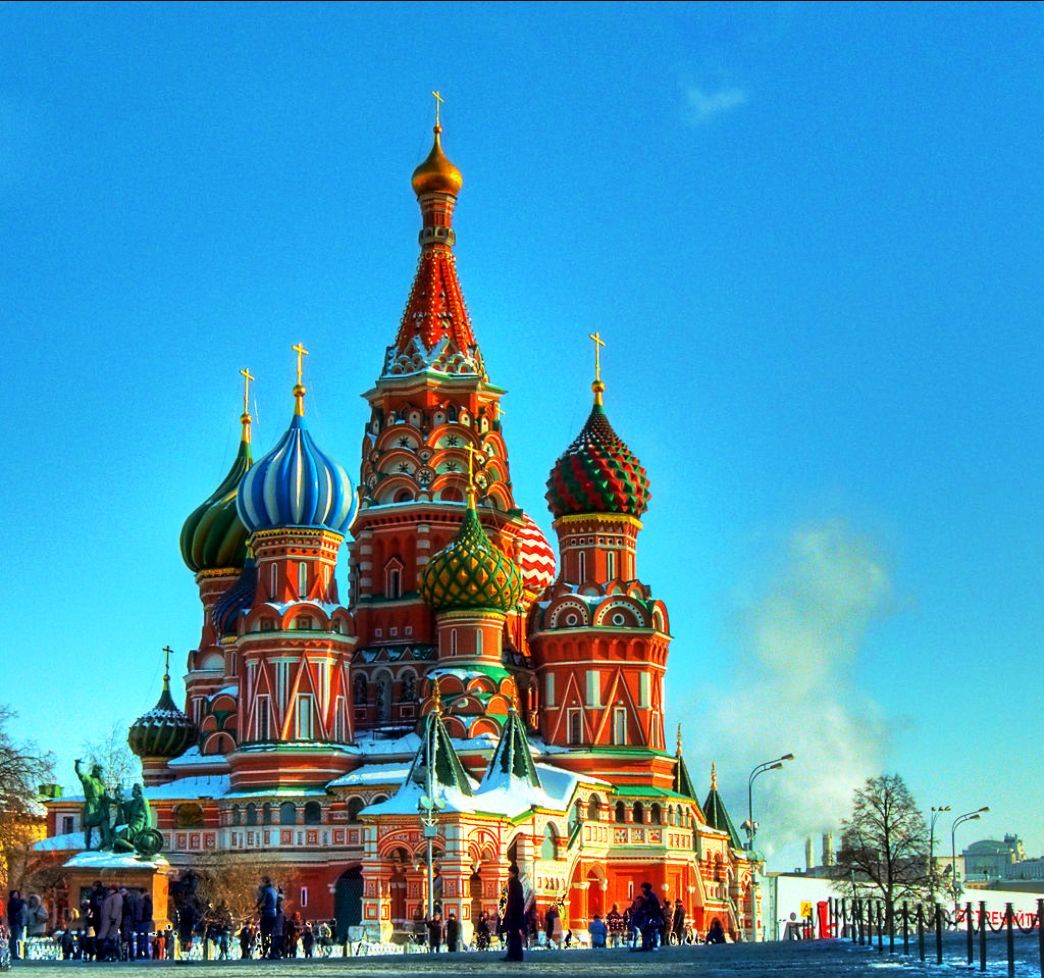
Nowadays, looking at the temple, it is difficult to believe that initially the cathedral was not so colorful: judging by the descriptions, the walls of the church were white. They began to repaint it some time later, and they did this by radically changing the appearance of the cathedral - historians discovered drawings on its walls depicting false windows, kokoshniks, and memorial inscriptions. Polychrome and floral painting on a red background appeared only at the end of the 17th century. Judging by the descriptions that have survived, in former times the Intercession Cathedral was more beautiful and elegant: it had more complex paintings, and the main dome was surrounded by smaller ones.
The appearance of the building was quite changed a hundred years after construction was completed: two porches were added, the external gallery was covered with vaults, and the walls were painted inside the cathedral. Therefore, in the temple you can see a combination of rare monuments of ancient Russian icon painting with frescoes of the sixteenth century, paintings of the seventeenth, and oil paintings of the eighteenth.
The temple was built taking into account the cardinal directions: focusing on them, they built four churches, and the same number were built diagonally. The Intercession Cathedral has nine churches: in the center is the main Church of the Intercession of the Mother of God, surrounded by four large (from 20 to 30 m) and four small churches (about 15 m), near which there was a bell tower and St. Basil's chapel. All these churches are located on the same foundation, have a common bypass gallery and are connected by internal corridors.
Domes of the Intercession Cathedral
At first, twenty-five domes were installed on the Intercession Cathedral, symbolizing the Lord and the elders located near his throne. Subsequently, only ten of them remained: one is located above the bell tower, the other rises above the chapel of St. Basil's, the rest - each above its own temple. At the same time, they are all different from each other: not only the design of the large domes is unique, but also the finishing of each drum.
Scientists suggest that initially the domes had a helmet-shaped shape, but were quickly replaced by a bulbous shape; the current colors appeared only in the middle of the 19th century, and until the 17th century. the temple had golden domes.
Temple today
Judging by the descriptions, throughout history, St. Basil's Cathedral was rebuilt and changed its appearance more than once (frequent fires, which were not uncommon in the city, also contributed to the need for frequent repair work).
For the first time, St. Basil's Cathedral was on the verge of extinction in 1812, when the French, leaving the capital of Russia, mined it (though for some reason they could not blow it up, but they plundered the church). When the war ended, the Intercession Cathedral was not only restored, but also on the river side its wall was decorated with a cast-iron fence.
The temple experienced the saddest times in the 20th century. In 1918, the Bolsheviks shot the rector of the church, Ivan Vostorgov, for “anti-Semitic propaganda.” Three years later, all valuables were removed from the cathedral, and the building was transferred to the Historical Museum. For some time it remained an active church, until in 1929 services were banned by removing all the bells (services in the cathedral were resumed only in 1991).
The second time the temple was on the verge of extinction was in 1936, when restorer Pyotr Baranovsky was asked to measure the temple in order to subsequently demolish it. In response to this, the architect categorically stated that this idea was insane and criminal, and threatened to commit suicide if it was carried out. Immediately after this, an arrest followed, but the church was not touched: it had too many defenders. Therefore, when he was released six months later, the temple stood in the same place.
In 1555, by order of Tsar Ivan IV the Terrible, a stone Cathedral was laid near the walls of the Moscow Kremlin - the Church of the Intercession of the Mother of God, which today is considered one of the symbols of Russia and is a monument of world significance, one of the sites protected by UNESCO.
Even during construction, the temple began to be called after the holy fool St. Basil, revered by Muscovites, who was buried near the walls old church. His relics, which granted healing from many diseases, were transferred to the Intercession Cathedral upon completion of its construction. Another name of the Temple is Jerusalem, it was given in honor of one of the chapels of the Intercession Church.
The Intercession Cathedral was built quickly by the standards of the 14th century - in just five years. The construction was preceded by a war with the Kazan Khanate, which Ivan the Terrible could not defeat for a long time, and therefore made a vow to build a new church if Kazan was taken. With each won battle, a new wooden church appeared on the square near the Kremlin, and upon returning from the campaign, the sovereign ordered a stone cathedral to be erected on the site of these churches and called it Intercession - on the Feast of the Intercession of the Holy Virgin, the final victory in the long war was won.
The construction was entrusted to the carpenters Barma and Postnik, although many researchers are inclined to believe that “Postnik” is most likely the nickname of the carpenter Ivan Barma. Legends also talk about the blinding of the architect on the orders of the king so that he could not repeat his success, however, this version is unlikely to be true. Documents from the 16th century clearly state that this master, after working on the cathedral in Moscow, participated in the construction of the Kazan Kremlin.
During its existence, the temple underwent many changes: chapels were completed, the domes were changed, the large gallery was covered with a vault and painted with ornaments, porches were built over the stairs, and the facades were updated with tiles. The domes were also replaced: initially they were helmet-shaped, elongated upward, but at the end of the 16th century they were replaced with onion-shaped domes with a unique decoration. The color of the domes was established only in the 19th century; before that, they, like the walls, external and internal, were often repainted, changing the design.
St. Basil's Cathedral was restored several times. The restoration and renovation of the building was necessary after the terrible Moscow fire of 1737, the capture of the capital by French troops and their plunder of the temple, at the same time the cathedral was mined and almost destroyed, and at the beginning of the 20th century it required good repairs and strengthening.
In 1918, the Cathedral officially became a historical monument, although this did not save it from its disastrous, abandoned situation and the confiscation of valuables by the new government. Despite the fact that the temple was a branch of the State Historical Museum, and religious services were now prohibited, there were attempts to demolish the building, but, by a lucky coincidence, they did not come to fruition.
Today, St. Basil's Cathedral is again painted to look like brick, as in the 16th century, the original appearance of the gallery has been restored, and the interior has been restored. Since 1990, services have been held here again. The cathedral, at the same time, remains part of the State Historical Museum, is under state protection and receives tourists from all over the world every day.
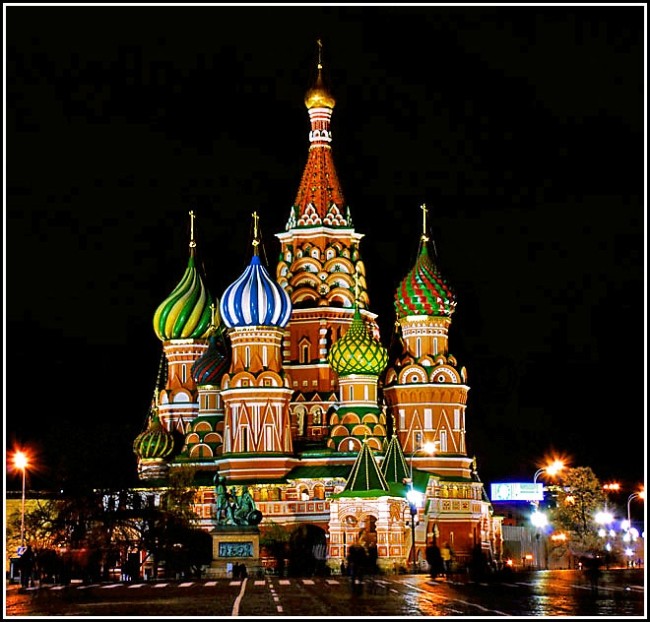

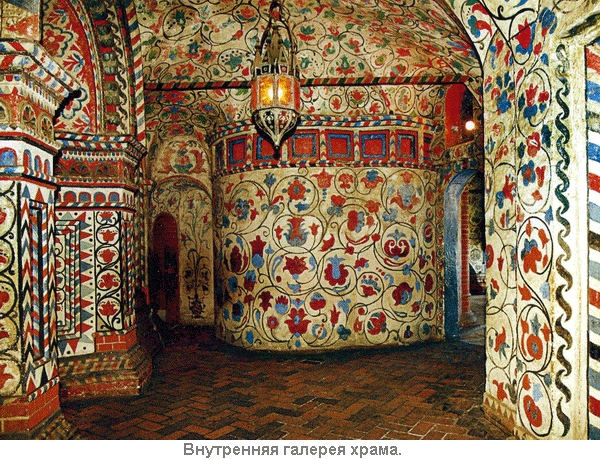
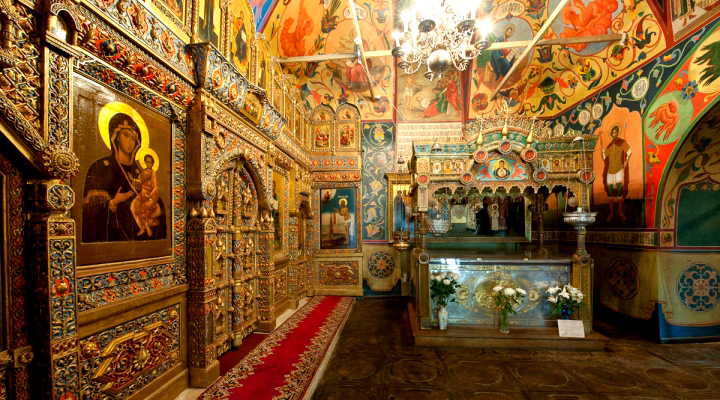
St. Basil's Cathedral brief information.
Cathedral of the Intercession, which is on the Moat, also called St. Basil's Cathedral - Orthodox church, located on Red Square in Moscow. A widely known monument of Russian architecture. Until the 17th century, it was usually called Trinity, since the original wooden church was dedicated to the Holy Trinity; was also known as “Jerusalem”, which is associated both with the dedication of one of the chapels and with what took place on Palm Sunday procession to him from the Assumption Cathedral with the “procession on the donkey” of the Patriarch.
Currently, the Intercession Cathedral is a branch of the State Historical Museum. Included in the List of objects World Heritage UNESCO in Russia.
The Intercession Cathedral is one of the most famous landmarks in Russia. For many inhabitants of planet Earth, it is a symbol of Moscow (the same as the Eiffel Tower for Paris). Since 1931, in front of the temple there has been a bronze Monument to Minin and Pozharsky (installed on Red Square in 1818).
Located in St. Petersburg memorial temple, dedicated to Alexander II, - the Church of the Resurrection of Christ, better known as the Savior on Spilled Blood (completed in 1907). The Intercession Cathedral served as one of the prototypes for the creation of the Savior on Spilled Blood, so both buildings have similarities.
The Intercession Cathedral was built in 1555-60 by order of Ivan the Terrible in memory of the capture of Kazan and the victory over the Kazan Khanate.
There are several versions about the creators of the cathedral.
According to one version, the architect was the famous Pskov master Postnik Yakovlev, nicknamed Barma.
According to another, widely known version, Barma and Postnik are two different architects, both involved in the construction; this version is now outdated.
According to the third version, the cathedral was built by an unknown Western European master (presumably an Italian, as before - a significant part of the buildings of the Moscow Kremlin), hence such a unique style, combining the traditions of both Russian architecture and European architecture of the Renaissance, but this version is still I never found any clear documentary evidence.
According to legend, the architect(s) of the cathedral were blinded by order of Ivan the Terrible so that they could not build another similar temple. However, if the author of the cathedral is Postnik, then he could not have been blinded, since for several years after the construction of the cathedral he participated in the creation of the Kazan Kremlin.
There are only 10 domes. Nine domes over the temple (According to the number of thrones: the Intercession of the Virgin Mary (central), Holy Trinity (eastern), Entrance to Jerusalem (western), Gregory of Armenia (north-western), Alexander of Svirsky (south) -east), Barlaam of Khutyn (south-west), John the Merciful (formerly John, Paul and Alexander of Constantinople) (north-east), Nicholas the Wonderworker of Velikoretsky (south), Adrian and Natalia (formerly Cyprian and Justina) (northern)) plus one dome over the bell tower. (In the old days, St. Basil's Cathedral had 25 domes, representing the Lord and the 24 elders sitting at His throne). The cathedral consists of eight churches, the altars of which were consecrated in honor of the holidays that occurred during the decisive battles for Kazan: Trinity, in honor of St. Nicholas the Wonderworker (in honor of his Velikoretskaya icon from Vyatka), Entry into Jerusalem, in honor of the martyr. Adrian and Natalia (originally - in honor of St. Cyprian and Justina - October 2), St. John the Merciful (before XVIII - in honor of St. Paul, Alexander and John of Constantinople - November 6), Alexander of Svir (April 17 and August 30), Varlaam of Khutyn (November 6 and the 1st Friday of Peter's Lent), Gregory of Armenia (September 30 ). All these eight churches (four axial, four smaller ones between them) are crowned with onion domes and grouped around the ninth pillar-shaped church rising above them in honor of the Intercession of the Mother of God, completed with a tent with a small dome. All nine churches are united by a common base, a bypass (originally open) gallery and internal vaulted passages.
In 1588, a chapel was added to the cathedral from the northeast, consecrated in honor of St. Basil the Blessed (1469-1552), whose relics were located on the site where the cathedral was built. The name of this chapel gave the cathedral a second, everyday name. Adjacent to the chapel of St. Basil's is the chapel of the Nativity of the Blessed Virgin Mary, erected over the burial place of the blessed one. John of Moscow (initially consecrated in honor of the Deposition of the Robe, but in 1680 reconsecrated as the Nativity of the Theotokos), where the relics of John the Blessed, found in 1672, rest.
Bell tower
A tented bell tower was built in the 1670s.
The cathedral has been restored several times. In the 17th century, asymmetrical extensions were added, tents over the porches, intricate decorative treatment of the domes (originally they were gold), and ornamental paintings outside and inside (originally the cathedral itself was white).
In the main, Intercession, church there is an iconostasis from the Kremlin Church of the Chernigov Wonderworkers, dismantled in 1770.
The last (before the revolution) rector of the cathedral, Archpriest John Vostorgov, was shot on August 23 (September 5), 1919. Subsequently, the temple was transferred to the disposal of the renovation community.
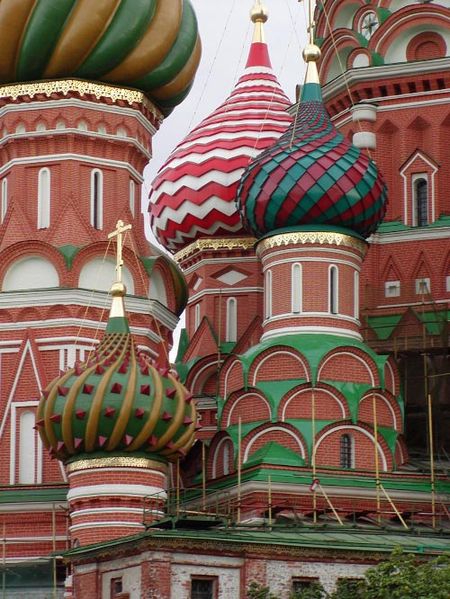
In 1929 it was closed for worship and the bells were removed. It began to be used for worship again on October 14 (Feast of the Intercession) 1991. Divine services are performed by clergy of churches in Zaryadye and Kitai-Gorod.
Since 1990, the temple-museum began collecting bells again. Currently, this collection is one of the richest existing collections not only in Moscow, but also in Russia. In total, the museum has 19 bells, created in 1547-1996 (casting places - the Urals, Yaroslavl, Moscow, as well as France, Holland, Germany, Western Belarus). The bells were cast by such famous masters as Fyodor and Ivan Motorin, Semyon Mozhzhukhin, P. I. Olovyashnikov, P. N. Finlyandsky, A. A. Samgin. The cathedral also has an interesting collection of weapons from the times of Ivan the Terrible.
Not far from the Kremlin's Spasskaya Tower, in the very heart, is the world-famous St. Basil's Cathedral. It has several other names: the Cathedral of the Intercession of the Blessed Virgin Mary, which is on the Moat, and also the Intercession Cathedral. Until the beginning of the 17th century, this monument of Russian architecture was called Trinity, since the ancient wooden church was built in honor of the Holy Trinity. Let's take a short excursion into history and find out who built St. Basil's Cathedral and where, in fact, this cathedral is located.
The history of the creation of St. Basil's Cathedral
In 1552, on the day of the Intercession of the Mother of God, Russian soldiers began the assault on Kazan, which, as is known, ended in victory over the Golden Horde. In honor of her, Tsar Ivan the Terrible ordered the construction of a cathedral that would immortalize such a joyful event.
Construction of the stone St. Basil's Cathedral on Red Square began two years later on the site where the wooden Trinity Church had previously been located, and where, according to legend, the holy fool, after whom the cathedral was named, was buried. There is a legend that St. Basil personally collected money for this Temple, but no one knows whether it was true or not. After all, the exact date of death of the holy fool has not been established. And yet, Fyodor, the son of Ivan the Terrible, ordered the creation of a chapel of St. Basil's in the Intercession Church, where his relics were placed.
The Intercession Cathedral was built over six years. The author of the main idea of the temple was Metropolitan Macarius, and it was implemented by two architects, Barma and Postnik. Another version of this says that the Intercession Cathedral was built by a Pskov craftsman nicknamed Barma. Another legend says that Ivan the Terrible was delighted with the beautiful temple and did not want an equally beautiful cathedral to be built somewhere else. Therefore, he asked the architect if he could erect an equally beautiful building. The master boldly replied that he could do it, and then the king became angry and ordered the architect to be blinded.
Style of St. Basil's Cathedral
The building of the Intercession Cathedral is a structure consisting of a central tent and eight main towers located around it. In plan it is a figure consisting of two combined squares, which together form an eight-pointed star, a symbol of the Blessed Virgin Mary. Also, the number eight symbolizes the day when Jesus Christ was resurrected and is a reminder of the Star of Bethlehem, which showed the way to the newborn Christ. The combination of two squares is a symbol of the fact that the Gospel has been spread to all directions of the world.
There is Saint Basil’s Cathedral in Red Square in Moscow. It is one of the outstanding symbols of the Russian Federation. It was built from 1555-1561 on orders from the tsar Ivan the Terrible by Russian architects Barma and Postnik to commemorate the capture of Kazan and Astrakhan.
The architecture of the cathedral is unique and amazing; it attracts the attention of historians, culture specialists, fine art experts and tourists.
The cathedral is an ensemble of eight churches of different shapes topped with onion domes that are traditional for the Russian architecture.
Each church is named in honor of the saint in whose memorable day there was an important event during the campaigns of the tsar Ivan the Terrible to Kazan. The central church is dedicated to the Eastern Orthodox feast of the Protection of the Theotokos. The building, now a museum, is officially known as the Cathedral of the Intercession of the Most Holy Theotokos on the Moat.
There is a legend that when Ivan the Terrible saw the cathedral of such an amazing beauty, he ordered to blind the masters, so that they were unable to repeat their masterpiece.
On Red Square in Moscow there is St. Basil's Cathedral - this is one of the brightest symbols Russian Federation. It was built by Russian architects Barma and Postnik in honor of the capture of Kazan and Astrakhan in 1555-1561 by order of Tsar Ivan the Terrible.
The architecture of the cathedral is unique and amazing; it attracts the attention of historians, cultural experts, art historians and tourists.
The cathedral is an ensemble of eight churches of different shapes, crowned with onion domes, traditional for Russian architecture.
Each church is named after a saint, on whose memorable day an important event took place during the campaigns of Tsar Ivan the Terrible to Kazan. The central church is dedicated Orthodox holiday Protection of the Mother of God. Officially the museum is called the Cathedral of the Intercession Holy Mother of God, which is on the Moat.
There is a well-known legend that, having seen a temple of such amazing beauty, Ivan the Terrible ordered the masters to be blinded so that they could not repeat their masterpiece.
